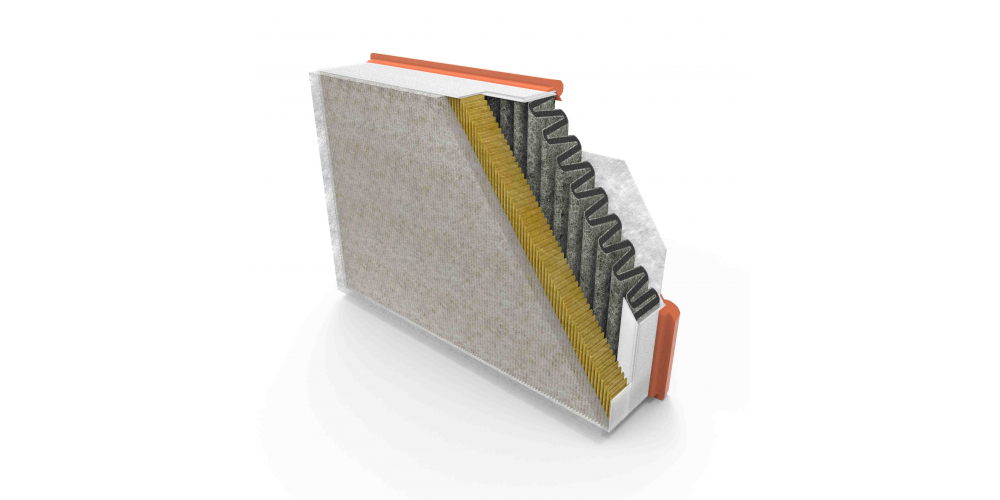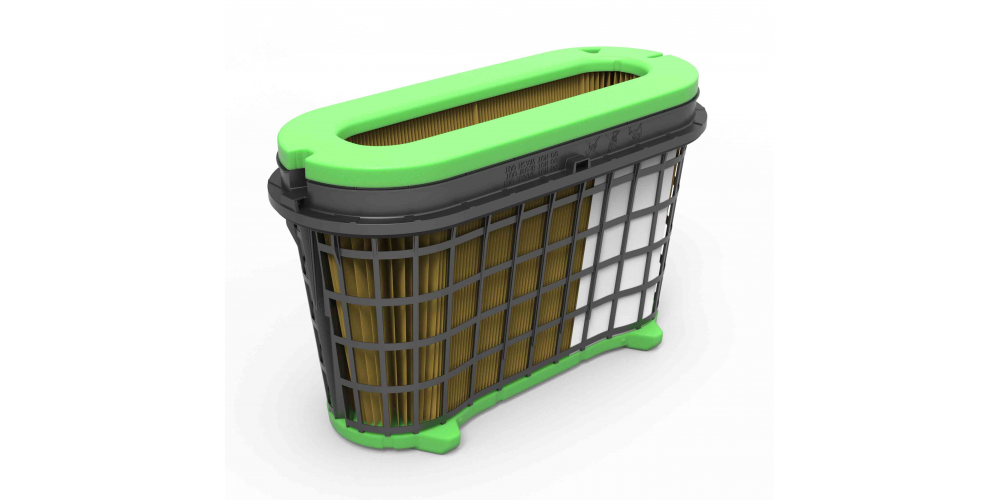MANN+HUMMEL GmbH Hall 8 / C11

Exhibitor Profile
MANN+HUMMEL is a leading global company in filtration technology.
Under its two business units Transportation and Life Sciences & Environment, the Ludwigsburg-based Group (Germany) develops intelligent filtration and separation solutions that enable cleaner mobility, cleaner air and cleaner water.
Thus, the 1941 founded family-owned company makes an important contribution to a clean earth and the sustainable use of limited resources. In 2021, over 23,000 employees at more than 80 locations generated a turnover of EUR 4.2 billion.
You can find further information on MANN+HUMMEL at https://www.mann-hummel.com/
Products / Markets
Product Index
- Abscheider - Öl/Dunst
- Absorptionsfilter
- Adsorptionsfilter
- Aktivkohle
- Aktivkohle Medien
- Automobilfilter
- Beschichtete Filter,antibakteriell
- Beutel-/Taschenfilter
- Filterelemente
- Hepa-Filter
- Kabinenfilter
- Luftfilter
- Luftfiltermedien
- Paneelfilter-Anlagen
- Patronenfilter
- Wasserfilter
- Zentrifugen
Market Scope
- Abwasserwirtschaft
- Automobilindustrie
- Bauindustrie
- Biotechnologie/Biopharmazie
- Halbleiterindustrie
- Lebensmittel-,Getränkeindustrie
- Medizintechnik, Health Care Industrie
- Milchindustrie / Molkerei
- Pharmazeutische Industrie
- Umweltschutz
Product Index
- Absorption Filters
- Activated Carbon
- Activated Carbon Media
- Adsorption Filters
- Air Filter Media
- Air Filters
- Automotive Filters
- Bag Filters
- Cabin Air Filters
- Cartridge Filters
- Centrifuges
- Coated Filters, antibacterical
- Filter Elements
- HEPA Filters
- Panel Filter Lines
- Separators - Oil/Mist
- Water Filters
Market Scope
- Automotive Industry
- Biotechnology/Biopharmac. Industry
- Building & Construction Services
- Dairy Industry
- Environmental Protection
- Food, Beverage Industry
- Medical, Health Care Industry
- Pharmaceutical Industry
- Semiconductor Industry
- Waste Water Treatment
Product Index
- 分离器 - 油/雾
- 吸附式过滤器
- 吸附式过滤器
- 水过滤器
- 汽车空调过滤器
- 汽车过滤器
- 活性碳
- 活性碳介质
- 滤筒
- 滤芯
- 离心机
- 空气过滤器
- 空气过滤器介质
- 袋式过滤器
- 镀膜滤色镜,抗菌式
- 面板式过滤器生产线
- 高效粒子空气过滤器
Market Scope
- 汽车工业
- 乳品加工业
- 制药工业
- 医疗卫生保健业
- 半导体工业
- 废水处理
- 建筑与施工服务业
- 环境保护
- 生物技术/生物制药业
- 食品、饮料工业
Product Index
- "فلاتر هواء عالية الفاعلية ""هـيبا"" HEPA"
- أكياس فلترة
- خطوط فلاتر صفائحية
- فلاتر إمتصاص
- فلاتر إمتصاص كيماوي
- فلاتر السيارات
- فلاتر الكارترج / الخراطيش
- فلاتر المقصورات والحُجرات
- فلاتر الهواء
- فلاتر ماء
- فلاتر مغلفة، مضادة للجراثيم
- فواصل الزيت والرذاذ
- قطع فلاتر
- كربون منشط
- مواد الكربون المنشط
- مواد فلاتر الهواء
- وحدات الطرد المركزي
Market Scope
- الصناعات الدوائية
- الصناعات الطبية والعناية الصحية
- الصناعات الغذائية وصناعة المشروبات
- الصناعة الإلكترونية والإلكترونيات الدقيقة
- خدمات البناء والإنشاء
- صناعة أنصاف النواقل
- صناعة الألبان
- صناعة التقنية البيولوجية والبيوصيدلية
- صناعة السيارات
- معالجة مياه الصرف
Product Index
- Cartouches de filtres
- Centrifugeuses
- Charbon actif
- Eléments de filtre
- Filtres HEPA
- Filtres automobiles
- Filtres à absorption
- Filtres à adsorption
- Filtres à air
- Filtres à air de cabines
- Filtres à eau
- Filtres à revêtement, antibactérien
- Filtres à sacs
- Fluide à charbon actif
- Fluides pour filtres à air
- Lignes de panneaux de filtres
- Séparateurs – huile/buées
Market Scope
- Industrie automobile
- Industrie biotechnologie/biopharmaceutique
- Industrie des semi-conducteurs
- Industrie du bâtiment et de la construction
- Industrie laitière
- Industrie médicale et de la santé
- Industrie pharmaceutique
- Industrie électronique et microélectrique
- Industries alimentaires et des boissons
- Traitement des eaux usées
Product Index
- Carbone attivo
- Centrifughe
- Elementi filtranti
- Filtri a tasche
- Filtri aria
- Filtri aria abitacolo
- Filtri cartuccia
- Filtri di assorbimento
- Filtri di assorbimento
- Filtri hepa
- Filtri per acqua
- Filtri rivestiti, antibatterici
- Filtri settore automobilistico
- Linee filtri a pannello
- Mezzi filtranti aria
- Mezzi filtranti carbone attivo
- Separatori - olio/nebbia
Market Scope
- Biotecnologie/biofarmaceutica
- Protezione ambientale
- Servizi settore edile
- Settore alimenti e bevande
- Settore automobilistico
- Settore caseario
- Settore industria dei semiconduttori
- Settore medicale e sanità
- Settore parafarmaceutico
- Trattamento acque reflue
Product Index
- Elementy filtra
- Filtry HEPA
- Filtry absorbcyjne
- Filtry adsorbcyjne
- Filtry do wody pitnej
- Filtry kasetowe
- Filtry powietrza
- Filtry powlekane, antybakteryjne
- Filtry samochodowe
- Filtry workowe
- Kabinowe filtry powietrza
- Media filtrów powietrza
- Media węgla aktywowanego
- Separatory - Olej/mgła
- Wirówki
- Wkłady filtracyjne
- Węgiel aktywowany
Market Scope
- Biotechnologia/biofarmaceutyka
- Ochrona zdrowia
- Ochrona środowiska
- Oczyszczanie ścieków (waste water)
- Produkcja półprzewodników
- Przemysł budowlany
- Przemysł farmaceutyczny
- Przemysł mleczarski
- Przemysł samochodowy
- Przemysł spożywczy
Product Index
- Carvão activado
- Centrifugadores
- Elementos filtrantes
- Filtros absolutos (HEPA)
- Filtros de absorção
- Filtros de adsorção
- Filtros de ar
- Filtros de ar para cabines
- Filtros de cartuchos
- Filtros de saco
- Filtros de água
- Filtros para automóveis
- Filtros revestidos, antibacteriano
- Instalações de filtros de painéis
- Meios de carvão activado
- Meios de filtro do ar
- Separadores - óleo/vapores
Market Scope
- Electrónica, indústria microelectrónica
- Ind. de biotecnologia/biofarmac.
- Indústria alimentar, de bebidas
- Indústria automóvel
- Indústria de semicondutores
- Indústria farmacêutica
- Indústria leiteira
- Indústria médica, cuidados de saúde
- Serviços de fabrico & construção
- Tratamento de água de despejo
Product Index
- Абсорбционные фильтры
- Абсорбционный фильтр
- Автомеханические фильтры
- Активированный уголь
- Водяные фильтры
- Воздушные фильтры
- Линии по производству фильтровальных панелей
- Материал активированного угля
- Рукавные фильтры
- Сепараторы – масло / туман
- Фильтрующие элементы
- Фильтрующий материал
- Фильтры воздуха в кабине
- Фильтры с покрытием, антибактериальные
- Фильтры со сменным фильтрующим элементом
- Фильтры тонкой очистки
- Центрифуги
Market Scope
- Автомобильная промышленность
- Биотехнология / Биофармацевтическая промышленность
- Медицина, здравоохранение
- Молочная промышленность
- Очистка сточных вод
- Полупроводниковая промышленность
- Производство продуктов питания и напитков
- Строительство жилых и общественных зданий
- Фармацевтическая промышленность
- Электроника, микроэлектроника
Product Index
- Carbón activado
- Centrífugas
- Elementos de filtro
- Filtros HEPA
- Filtros de absorción
- Filtros de absorción
- Filtros de agua
- Filtros de aire
- Filtros de aire de cabina
- Filtros de automoción
- Filtros de bolsa
- Filtros de cartucho
- Filtros revestidos, antibacteriológicos
- Líneas de filtros de paneles
- Medios de carbón activado
- Medios de filtros de aire
- Separadores - aceite/neblina
Market Scope
- Industria de la alimentación y las bebidas
- Industria de la automoción
- Industria de la biotecnología/biofarmacéutica
- Industria de la electrónica, microelectrónica
- Industria de los productos lácteos
- Industria de los semiconductores
- Industria farmacéutica
- Industria médica, de la atención sanitaria
- Servicios de edificación y construcción
- Tratamiento de aguas residuales
Product Index
- Absorpsiyon Filtreleri
- Adsorpsiyon Filtreleri
- Aktif Karbon
- Aktif Karbon Ortamı
- Filtre Elemanları
- HEPA Filtreler
- Hava Filtreleri
- Hava Filtresi Ortamı
- Kabin Hava Filtreleri
- Kaplı Filtreler, antibakteriyel
- Kartuşlu Filtreler
- Otomobil Filtreleri
- Panel Filtre Hatları
- Santrifüjler
- Separatörler - Yağ/Buğu
- Su Filtreleri
- Torba Filtreler
Market Scope
- Atıksu Arıtma
- Bina ve İnşaat Hizmetleri
- Biyoteknoloji/Biyoeczacılık Endüstrisi
- Gıda, İçecek Endüstrisi
- Otomotiv Endüstrisi
- Süt Endüstrisi
- Tıp, Sağlık Sektörü
- Yarıiletken Endüstrisi
- Çevre Koruma
- İlaç Endüstrisi
Product Index
- HEPA 필터
- 공기 여과재
- 공기 필터
- 물 필터
- 백 필터
- 분리기
- 분리기 - 오일/미스트
- 자동차 필터
- 카트리지 필터
- 캐빈 에어 필터
- 코팅 필터, 항균성
- 패널 필터 라인
- 필터 엘리먼트
- 활성탄
- 활성탄 매체
- 흡수 필터
- 흡수 필터
Market Scope
- 건축 및 건설 용역
- 반도체 산업
- 생명공학/생물 약제학 산업
- 식음료 산업
- 유제품 산업
- 의료, 보건 산업
- 자동차 산업
- 제약 산업
- 폐수 처리
- 환경 보호
Product Index
- HEPAフィルター
- エアフィルター
- エアフィルターメディア
- カートリッジ・フィルター
- キャビン用エアフィルター
- コーティングフィルター
- バッグフィルター
- パネルフィルターライン
- フィルターエレメント
- 分離機 - オイル・ミスト
- 吸収フィルター
- 吸収フィルター
- 水フィルター
- 活性炭
- 活性炭メディア
- 自動車用フィルター
- 遠心分離機
Market Scope
- バイオテクノロジー・バイオ医薬品産業
- 医療、ヘルスケア業界
- 医薬品業界
- 半導体業界
- 建築・建設業
- 汚水処理
- 環境保護
- 自動車産業
- 酪農産業
- 食品、飲料業界

